An Impedance Measurement Technique for Composite Materials Moisture Level Detection Devoted to Health Monitoring in Aeronautics
Abstract
:1. Introduction
2. Materials and Methods
- Surface was not conductive (a sufficiently thick layer of insulating epoxy resin was present)
- Lateral planes were conductive, probably due to the cutting method that connected together the carbon fiber of the various layers.
2.1. Test Set-Up
2.2. Test Description
- Wet phase. The specimens are conditioned in a saturated environment (bath in distilled water at T = 80 °C) as required by ASTM 5229 (wet phase—ref. [11,12]).
- For measurement, the specimens are removed from the bath, dried on the surface and weighed with a precision electronic balance.
- Then the electrical measurement is performed as described in the following chapter.
In order not to alter the level of moisture absorption, the specimens are kept out of the bath no more than 30 min (the duration of each set of a + b. measurements is, therefore, less than 30 min). - Dry phase. Once the “saturation level” of the wet phase was reached, in which the phenomena of irregularity of the measurements begin to appear with respect to those of the previous measurement points, the specimens were subjected to a dry phase, also measuring the trend of the electrical parameters as a function of moisture absorption level. During the dry phase the specimens are conditioned in a ventilated oven at a constant temperature of 80 °C, in order to eliminate all the humidity present inside them. The mass and electrical measurements continue as in the previous phase, until the complete dehydration of the specimens is achieved. At the end of this phase, the mass M0 of each specimen is detected.
2.3. Electrical Measurement
2.3.1. The Measuring Instrument
2.3.2. Measurement Scheme
2.3.3. Measurement Details
- a pair of measurement, called test piece 1A, placed laterally on the facing surfaces of the first specimen;
- a measurement pair, called test piece 1B, at the center of the first specimen surfaces;
- a measurement pair, called specimen 2, at the center of the second specimen.
- Z, Theta (modulus and phase of the impedance)
- Y, Theta (modulus and phase of the admittance)
- Cp, D (capacity and dissipation factor of the parallel equivalent circuit, i.e., assuming to have a simplified equivalent circuit configuration corresponding to a parallel of a capacitor plus a resistor—see Figure 2, box B)
- Cs, Rs (capacity and resistance of the equivalent series circuit, made of a capacitor plus a resistor serially connected—see Figure 2, box C)
2.4. Mass Measurement (Absorbed Moisture Level)
2.5. Data Sets
- Z(m), Theta(m)
- Y(m), Theta(m)
- Cp(m), D(m)
- Cs(m), Rs(m)
2.6. Data Reduction and Graphics
3. Results
3.1. Interpretation of Results
3.2. Further Data Selection and Choice of the Electric Parameter
- The observation was reduced to the nearest curves to a linear trend, evaluated in the reduced frequency range 1–200 kHz.
- Finally, the electric parameter whose curves had a lower data dispersion was chosen as representative of the hydration state of the specimen.
4. Discussion and Conclusions
- The method can apply a wide range of low and medium frequencies from 1 to 200 kHz of electric stimuli. Preliminary setup allows one to identify a narrow range of frequencies stimuli that optimizes the data storage reducing the number of acquisitions to just one value. In fact, the proposed method allows one to adjust, on the base of the material to be monitored, the frequency of the stimulus signal of the measuring set up, in order to induce a rather linear response with respect to the moisture uptake. After that, just a single measurement of the impedance modulus could synthetically describe the status of the structure related to the moisture uptake.
- Previous studies discouraged the use of dielectric analysis for moisture content evaluations: It is not possible to clearly know the status of the water inside the structure, that could be bound or interstitial [15]. Water can exist in polymers as bound water, characterized by strong molecular interactions with the matrix, and as free water present in capillaries and micro-cavities within the polymer. The values of the dielectric properties of water in these two forms are not well known and in general lie between those of ice and liquid water [16]. So dielectric measurements have limitations and quantitative measurements of water uptake in polymers are not usually performed by dielectric analysis. But, for SHM purpose, this is not so important to have absolute measurements, because it is just needed a differential evaluation with respect to a structure pristine initial status, or intermediate time, after some operative flights. So, by recording the initial measurement, the current health status of the structure is easily derived. Thus, the dielectric analysis by measurements of the impedance modulus of the CML EEC becomes a viable path for SHM.
- Furthermore, as previous studies assessed [3], it is not affected by the disadvantages found in other more traditional methods, such as the gravimetric method, which, moreover, is not suitable for measurements during the operational life of an aircraft. A dedicated sensor network should be applied to the structure in order to monitor its moisture uptake. Final calibration of the impedance methods will take into account the effects of the electrodes’ presence on external specimen surfaces. Correction factor will be evaluated by using numerical analysis as well.
- Anyway, the study releases a possible new trend in SHM systems for composite materials in aeronautics.
Supplementary Materials
Author Contributions
Funding
Acknowledgments
Conflicts of Interest
References
- EASA AMC 20–29 Acceptable Means of Compliance for Airworthiness of Products, Parts and Appliances—Composite Aircraft Structure, 26 July 2010. Annex II to ED decision 2010/003/R of 19/07/2010. Available online: https://www.easa.europa.eu/sites/default/files/dfu/Annex%20II%20-%20AMC%2020-29.pdf (accessed on 23 July 2019).
- Shen, C.-H.; Springer, G.S. Effects of Moisture and Temperature on the Tensile Strength of Composite Materials. J. Compos. Mater. 1977, 11, 2–16. [Google Scholar] [CrossRef]
- Grammatikos, S.A.; Ball, R.J.; Evernden, M.; Jones, R.G. Impedance spectroscopy as a tool for moisture uptake monitoring in construction composites during service. Compos. Part A 2018, 105, 108–117. [Google Scholar] [CrossRef]
- Maffezzoli, A.M.; Peterson, L.; Seferis, J.C.; Kenny, J.; Nicolais, L. Dielectric characterization of water sorption in epoxy resin matrices. Polym. Eng. Sci. 1993, 33, 75–81. [Google Scholar] [CrossRef]
- Davis, G.D.; Rich, M.J.; Harichandran, R.S.; Drzal, L.T.; Mase, T.; Al-Ostaz, A. Development of an Electrochemical Impedance Sensor to Monitor Delamination and Moisture Uptake in CFRP-Reinforced Concrete Structures. In Proceedings of the 81st TRB 2003 Annual Meeting, Washington, DC, USA, 13–17 January 2002. [Google Scholar]
- Fraga, A.N.; Frulloni, E.; de la Osa, O.; Kenny, J.M.; Vàzquez, A. Relationship between water absorption and dielectric behaviour of natural fibre composite materials. Polym. Test. 2006, 25, 181–187. [Google Scholar] [CrossRef]
- King, R.J.; Basuel, J.C. Measurement of basis weight and moisture content of composite boards using microwaves. For. Prod. J. 1993, 43, 15–22. [Google Scholar]
- Boinard, P.; Banks, W.M.; Pethrick, R.A. Changes in the dielectric relaxations of water in epoxy resin as a function of the extent of water ingress in carbon fibre composites. Polimer 2005, 46, 2218–2229. [Google Scholar] [CrossRef]
- Wandowski, T.; Malinowski, P.; Skarbek, L.; Ostachowicz, W. Moisture detection in carbon fiber reinforced polymer composites using electromechanical impedance technique. Proc. Inst. Mech. Eng. Part C J. Mech. Eng. Sci. 2016, 230, 331–336. [Google Scholar] [CrossRef]
- Banks, W.M.; Dumolin, F.; Haywardd, D.; Pethrickd, R.A.; Lid, Z.C. Non-destructive examination of composite joint structures: A correlation of water absorption and high-frequency dielectric propagation. J. Phys. D Appl. Phys. 1996, 29, 233. [Google Scholar] [CrossRef]
- ASTM D5229/D5229M-14e1—Standard Test Method for Moisture Absorption Properties and Equilibrium Conditioning of Polymer Matrix Composite Materials; ASTM International: West Conshohocken, PA, USA, 2014.
- Department of Defense Handbook Composite materials handbook volume 1. Polymer Matrix Composites Guidelines for Characterization of Structural Materials (MIL-HBDK 17); U.S. Department of Defense: Arlington, VA, USA, 2002; ISBN 978-1-59124-509-4.
- Overview of Two-Wire and Four-Wire (Kelvin) Resistance Measurements; Keithley (Tektronix) Application Note n.3176; Keithley Instruments: Solon, OH, USA, 2012.
- Shen, C.-H.; Springer, G.S. Moisture Absorption and Desorption of Composite Materials. J. Compos. Mater. 1976, 10, 2–20. [Google Scholar] [CrossRef]
- Mikols, W.J.; Seferis, J.C.; Apicella, A.; Nicolais, L. Evaluation of structural changes in epoxy systems by moisture sorption-desorption and dynamic mechanical studies. Polym. Compos. 1982, 3, 118–124. [Google Scholar] [CrossRef]
- Hasted, J.B. Aqueous Dielectrics; Chapman and Hall: London, UK, 1973. [Google Scholar] [CrossRef]
- Di Palma, L.; Sorrentino, A.; Vitiello, P.; Izzo, C. Composite Structural Health Monitoring for MALE UAV Application. In Proceedings of the SAE 2013 AeroTech Congress & Exhibition, Montreal, QC, Canada, 24–26 September 2013. [Google Scholar]
- Sorrentino, A.; De Fenza, A. Improved Elliptical Triangulation Method for Damage Detection in Composite Material Structures. J. Mech. Eng. Sci. 2017, 231, 3011–3023. [Google Scholar] [CrossRef]




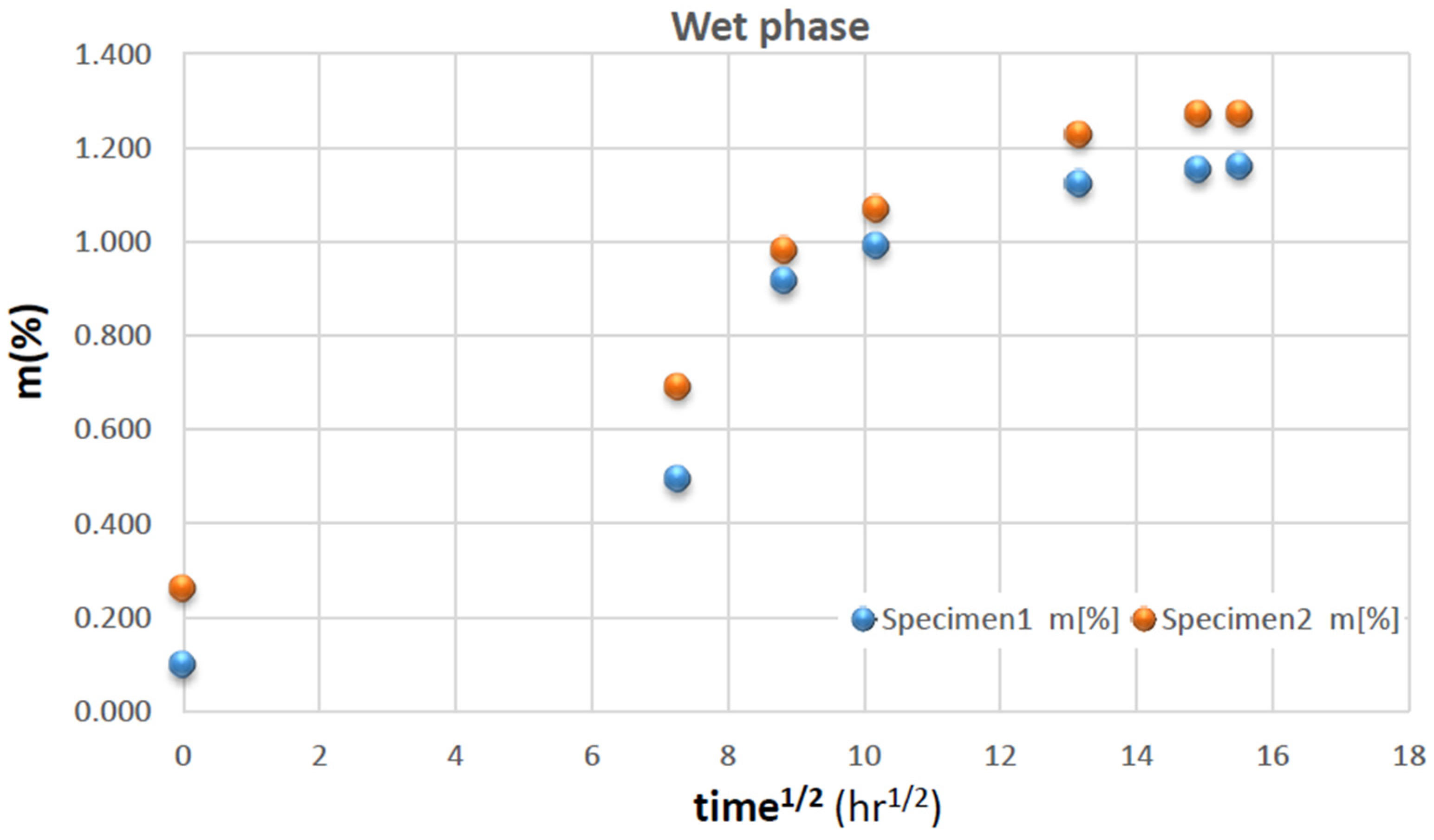

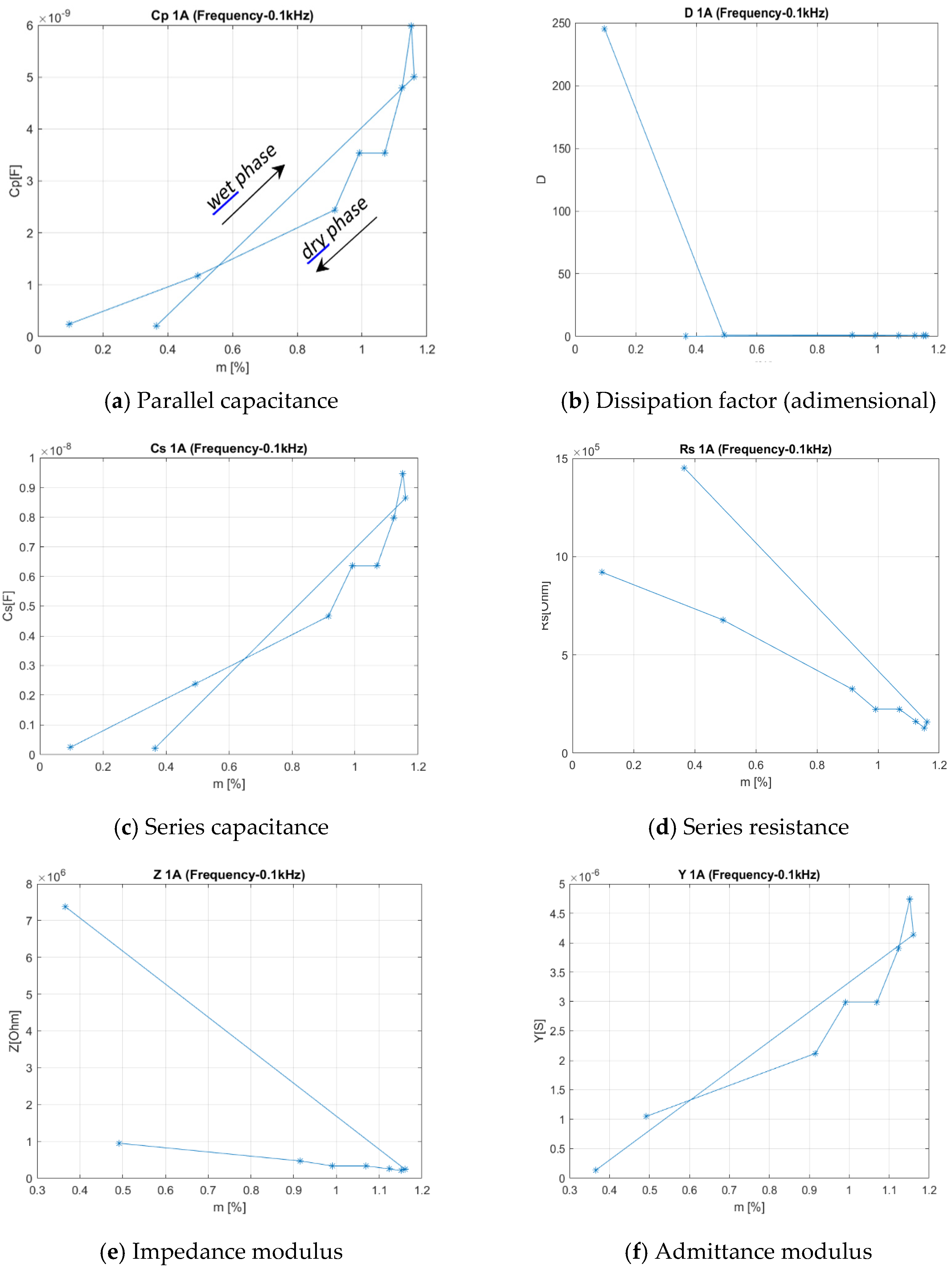
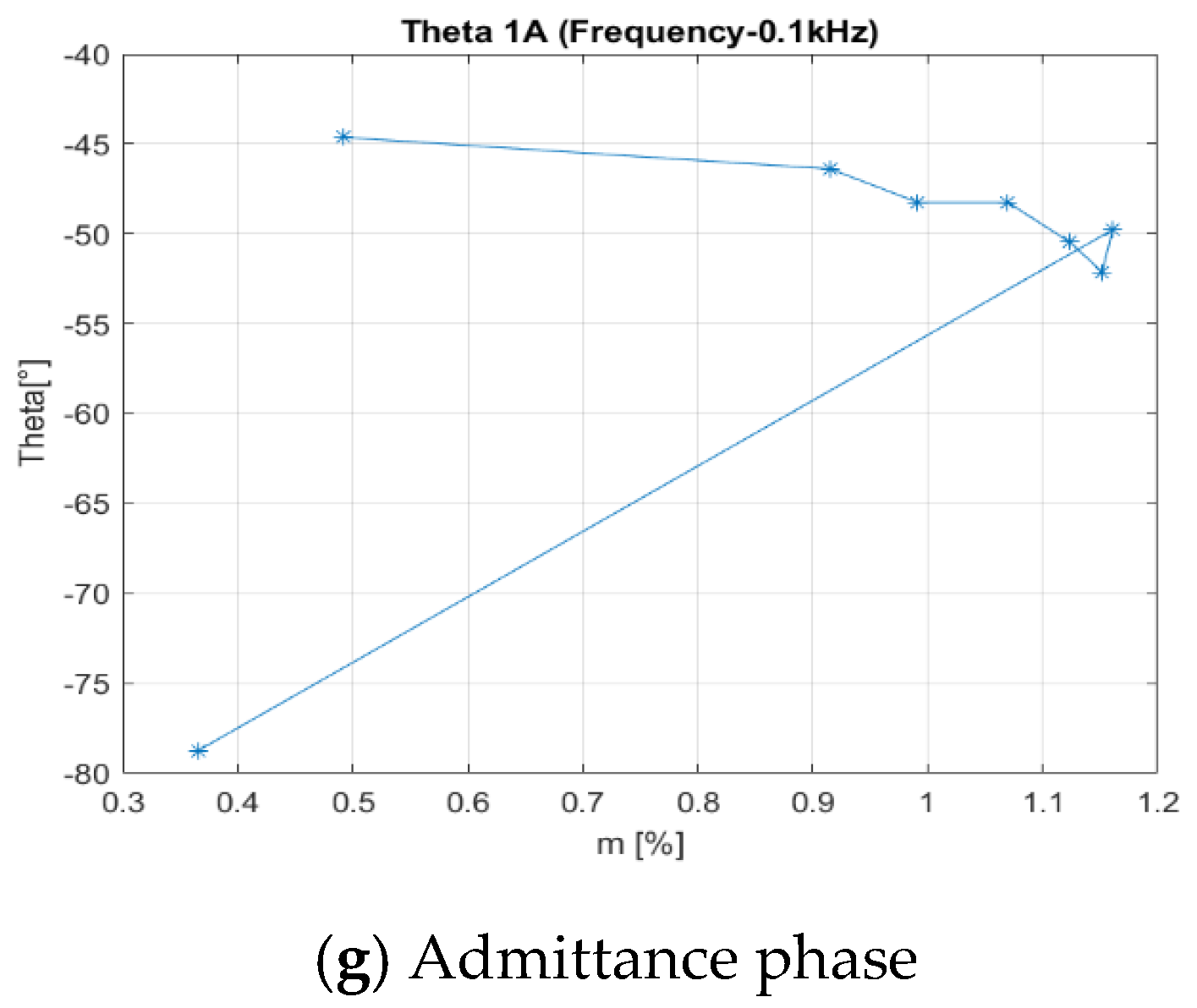
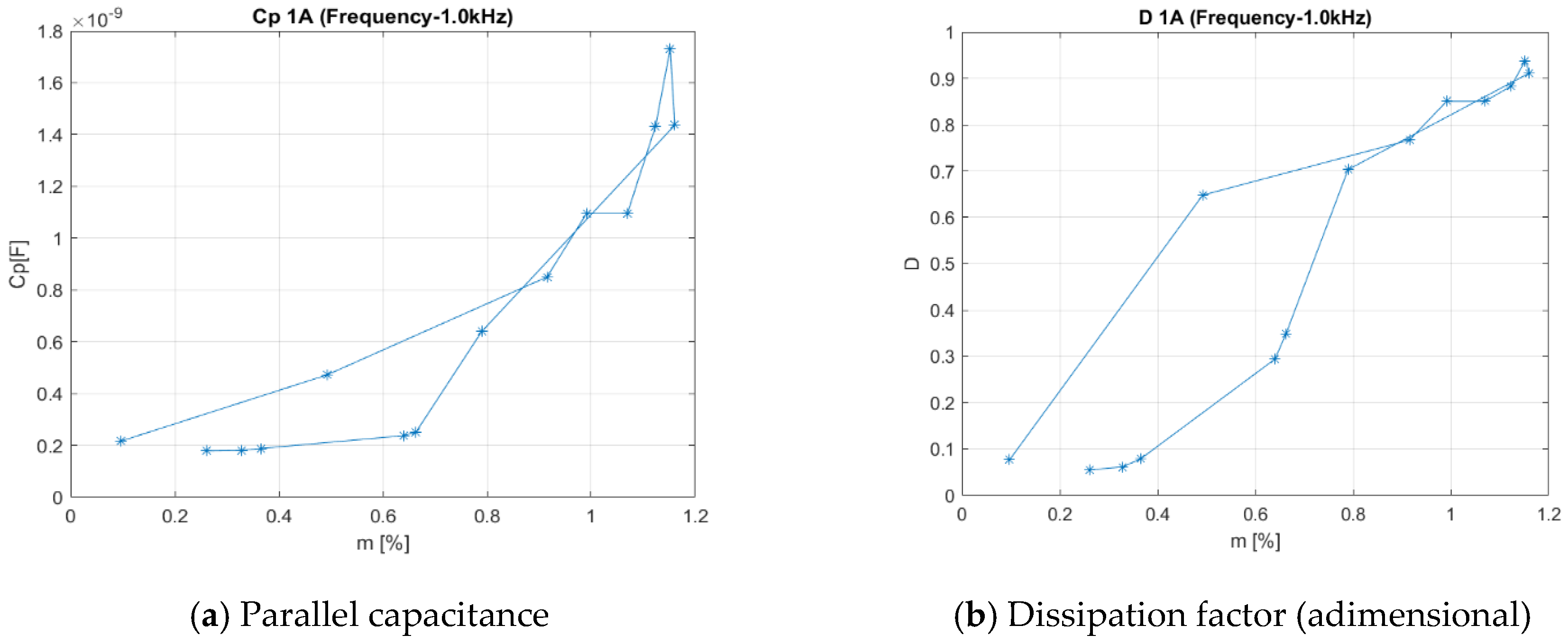

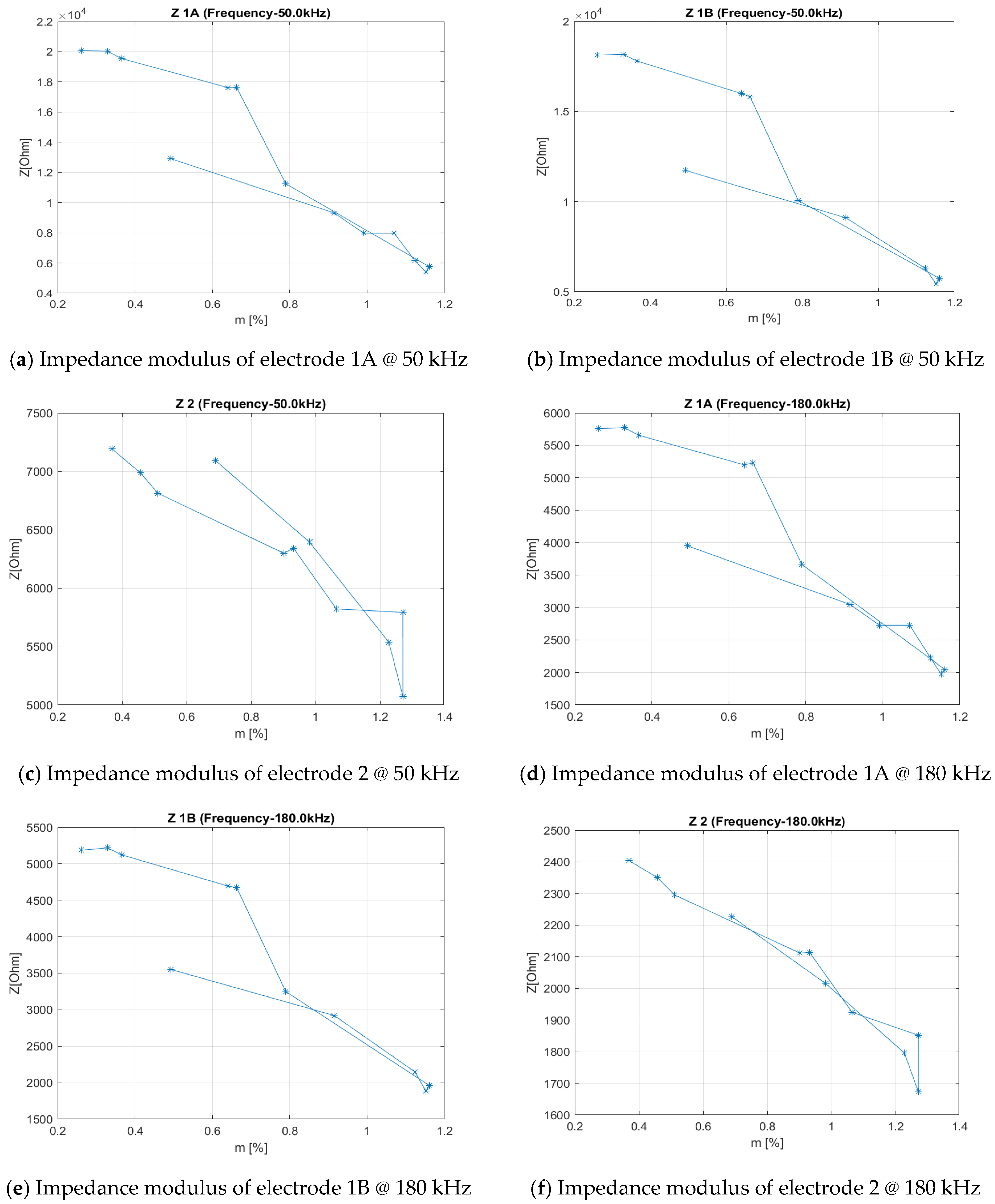
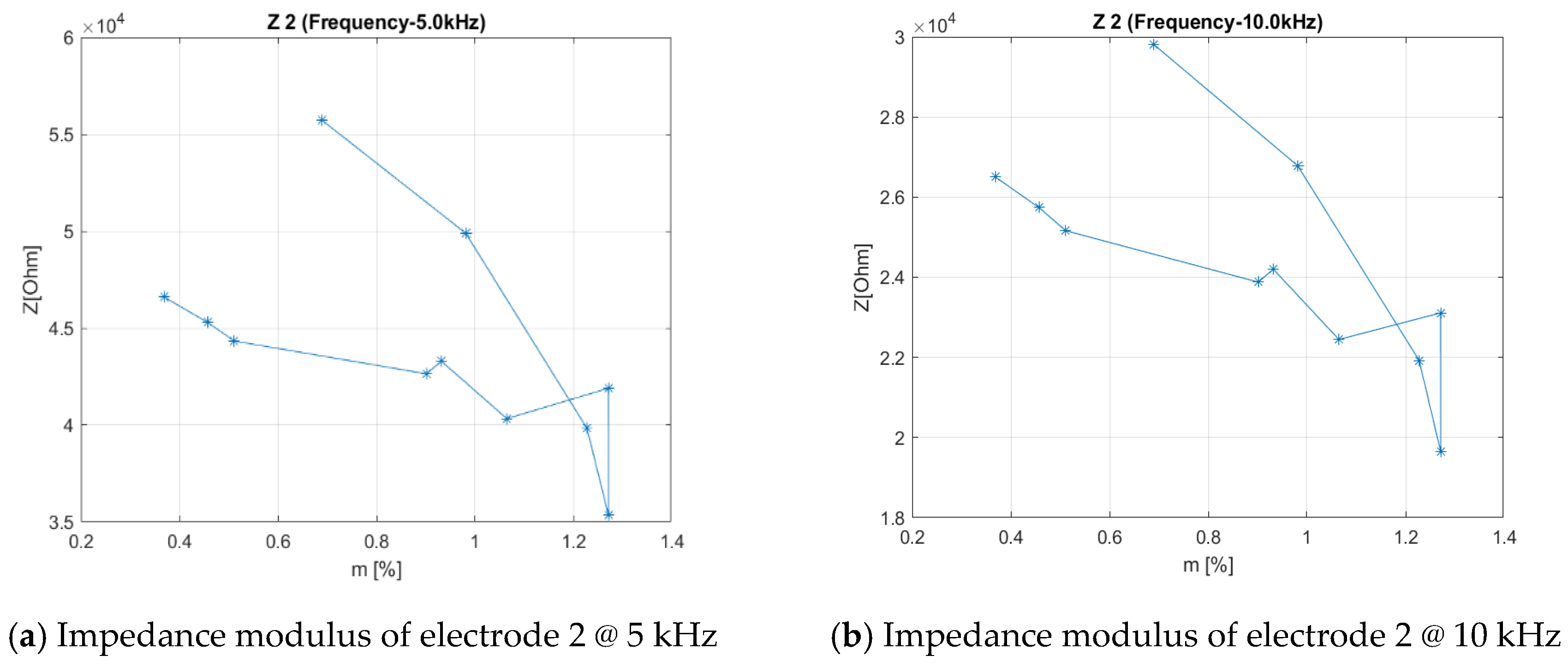

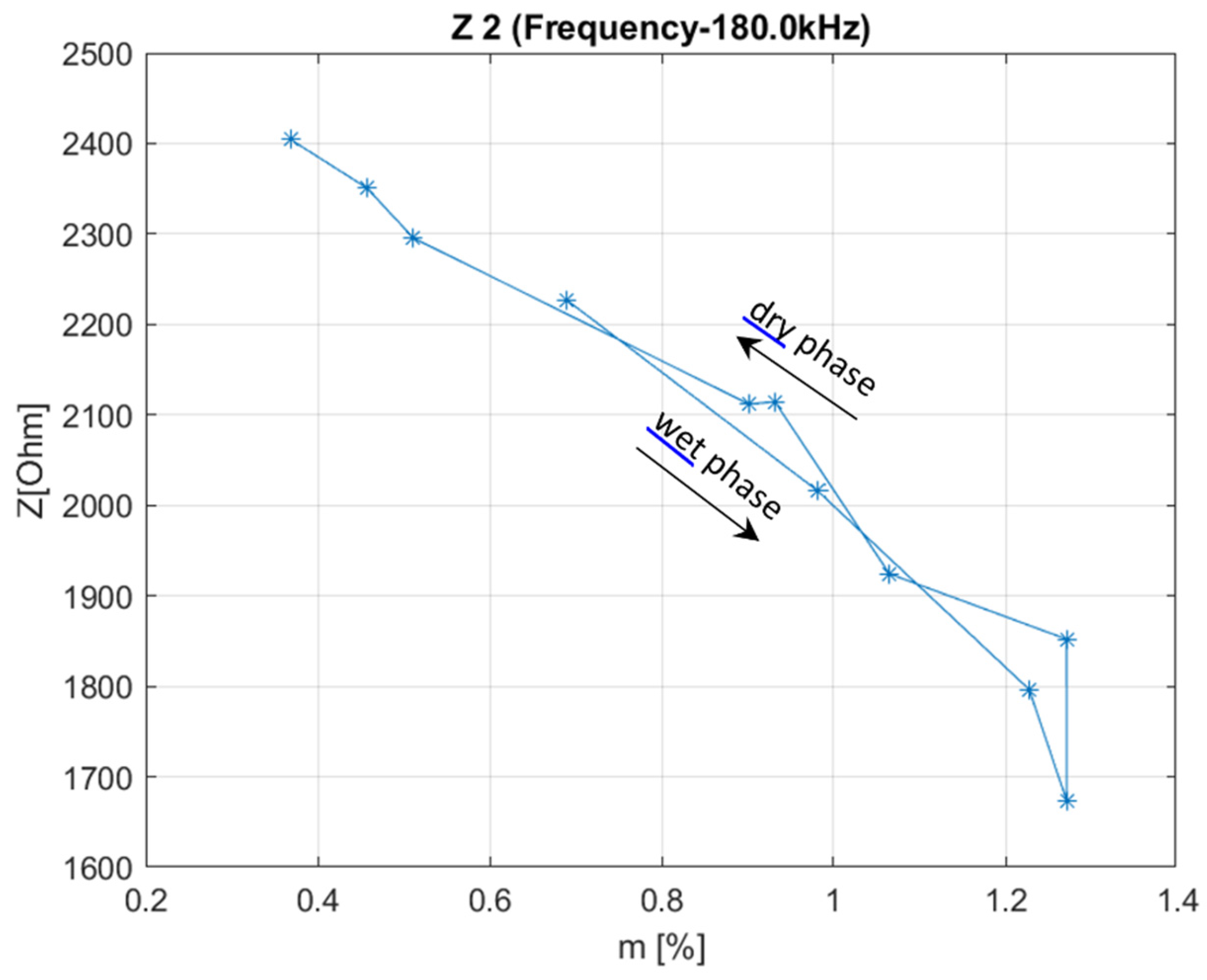

| CML Cutting # | Dimensions (mm) | Mass *,§ (g) | Fiber Volume Ratio |
| CML 1 | 150 × 101 × 2.5 | 55.1456 | 65% |
| CML 2 | 149 × 100 × 2.5 | 52.8785 | 65% |
| Electrode pair # | Dimensions of Each Electrode (mm) | Mass *,§ of the Pair of Electrodes (g) | |
| 1A | 30 × 30 × 1 | 11.1646 | |
| 1B | 30 × 30 × 1 | 11.1621 | |
| 2 | 30 × 30 × 1 | 11.1598 | |
| Specimen (CML + Electrodes + wires + glue) **,# | Mass,M0*,§§ (g) | ||
| Specimen 1 | 82.3637 | ||
| Specimen 2 | 68.2620 |
© 2019 by the authors. Licensee MDPI, Basel, Switzerland. This article is an open access article distributed under the terms and conditions of the Creative Commons Attribution (CC BY) license (http://creativecommons.org/licenses/by/4.0/).
Share and Cite
Sorrentino, R.; Di Palma, L.; Inverno, M.; Vernillo, P. An Impedance Measurement Technique for Composite Materials Moisture Level Detection Devoted to Health Monitoring in Aeronautics. J. Compos. Sci. 2019, 3, 76. https://doi.org/10.3390/jcs3030076
Sorrentino R, Di Palma L, Inverno M, Vernillo P. An Impedance Measurement Technique for Composite Materials Moisture Level Detection Devoted to Health Monitoring in Aeronautics. Journal of Composites Science. 2019; 3(3):76. https://doi.org/10.3390/jcs3030076
Chicago/Turabian StyleSorrentino, Romualdo, Luigi Di Palma, Michele Inverno, and Paolo Vernillo. 2019. "An Impedance Measurement Technique for Composite Materials Moisture Level Detection Devoted to Health Monitoring in Aeronautics" Journal of Composites Science 3, no. 3: 76. https://doi.org/10.3390/jcs3030076





